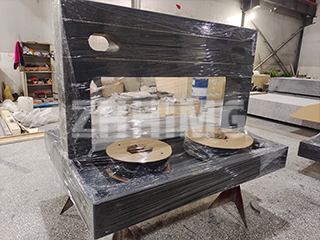1. Structural Composition of an Optical Platform
High-performance optical tables are designed to meet the demands of ultra-precise measurement, inspection, and laboratory environments. Their structural integrity is the foundation for stable operation. The key components include:
-
Fully Steel-Constructed Platform
A quality optical table typically features an all-steel build, including a 5mm-thick top and bottom skin paired with a 0.25mm precision-welded steel honeycomb core. The core is manufactured using high-precision pressing molds, and welding spacers are used to maintain consistent geometric spacing. -
Thermal Symmetry for Dimensional Stability
The platform structure is symmetric across all three axes, ensuring uniform expansion and contraction in response to temperature changes. This symmetry helps maintain excellent flatness even under thermal stress. -
No Plastic or Aluminum Inside Core
The honeycomb core extends fully from the top to the bottom steel surface without any plastic or aluminum inserts. This avoids a drop in rigidity or the introduction of high thermal expansion rates. Steel side panels are used to protect the platform from humidity-related deformation. -
Advanced Surface Machining
The table surfaces are finely finished using an automated matte polishing system. Compared to outdated surface treatments, this delivers smoother, more consistent surfaces. After surface optimization, the flatness is maintained within 1μm per square meter, ideal for precise instrument mounting.
2. Optical Platform Testing & Measurement Methods
To ensure quality and performance, each optical platform undergoes detailed mechanical testing:
-
Modal Hammer Testing
A known external force is applied to the surface using a calibrated impulse hammer. A vibration sensor is affixed to the surface to capture response data, which is analyzed through specialized equipment to produce a frequency response spectrum. -
Flexural Compliance Measurement
During R&D, multiple points on the table surface are measured for compliance. The four corners generally exhibit the highest flexibility. For consistency, most reported flexural data is collected from these corner points using flat-mounted sensors. -
Independent Test Reports
Every platform is tested individually and comes with a detailed report, including the measured compliance curve. This provides a more accurate performance representation than general, size-based standard curves. -
Key Performance Metrics
Flexural curves and frequency response data are critical benchmarks that reflect platform behavior under dynamic loads—especially under less-than-ideal conditions—providing users with realistic expectations of isolation performance.
3. Function of Optical Vibration Isolation Systems
Precision platforms must isolate vibration from both external and internal sources:
-
External vibrations may include floor movements, footsteps, door slams, or wall impacts. These are typically absorbed by the pneumatic or mechanical vibration isolators integrated into the table legs.
-
Internal vibrations are generated by components such as instrument motors, airflow, or circulating cooling fluids. These are attenuated by the internal damping layers of the tabletop itself.
Unmitigated vibration can severely affect instrument performance, leading to measurement errors, instability, and disrupted experiments.
4. Understanding Natural Frequency
The natural frequency of a system is the rate at which it oscillates when not influenced by external forces. This is numerically equal to its resonance frequency.
Two key factors determine the natural frequency:
-
Mass of the moving component
-
Stiffness (spring constant) of the support structure
Reducing mass or stiffness increases the frequency, while increasing mass or spring stiffness lowers it. Maintaining optimal natural frequency is crucial to prevent resonance issues and maintain accurate readings.
5. Air-Floating Isolation Platform Components
Air-floating platforms use air bearings and electronic control systems to achieve ultra-smooth, contact-free motion. These are often categorized into:
-
XYZ linear air-bearing stages
-
Rotary air-bearing tables
The air bearing system includes:
-
Planar air pads (air floatation modules)
-
Linear air tracks (air-guided rails)
-
Rotational air spindles
6. Air Flotation in Industrial Applications
Air-floatation technology is also widely adopted in wastewater treatment systems. These machines are designed to remove suspended solids, oils, and colloidal matter from various types of industrial and municipal wastewater.
One common type is the vortex air flotation unit, which uses high-speed impellers to introduce fine bubbles into the water. These microbubbles adhere to particles, causing them to rise and be removed from the system. The impellers typically rotate at 2900 RPM, and bubble generation is enhanced by repeated shearing through multi-blade systems.
Applications include:
-
Refining and petrochemical plants
-
Chemical processing industries
-
Food and beverage production
-
Slaughterhouse waste treatment
-
Textile dyeing and printing
-
Electroplating and metal finishing
Summary
Optical air-floating platforms combine precision structure, active vibration isolation, and advanced surface engineering to provide unmatched stability for high-end research, inspection, and industrial use.
We offer custom solutions with micron-level accuracy, backed by full test data and OEM/ODM support. Contact us for detailed specs, CAD drawings, or distributor cooperation.
Post time: Jul-30-2025

